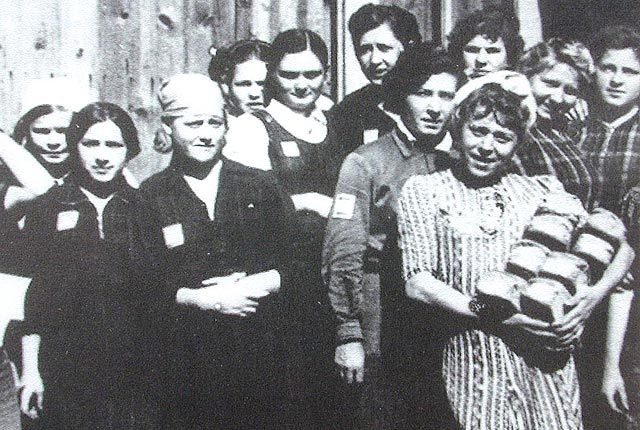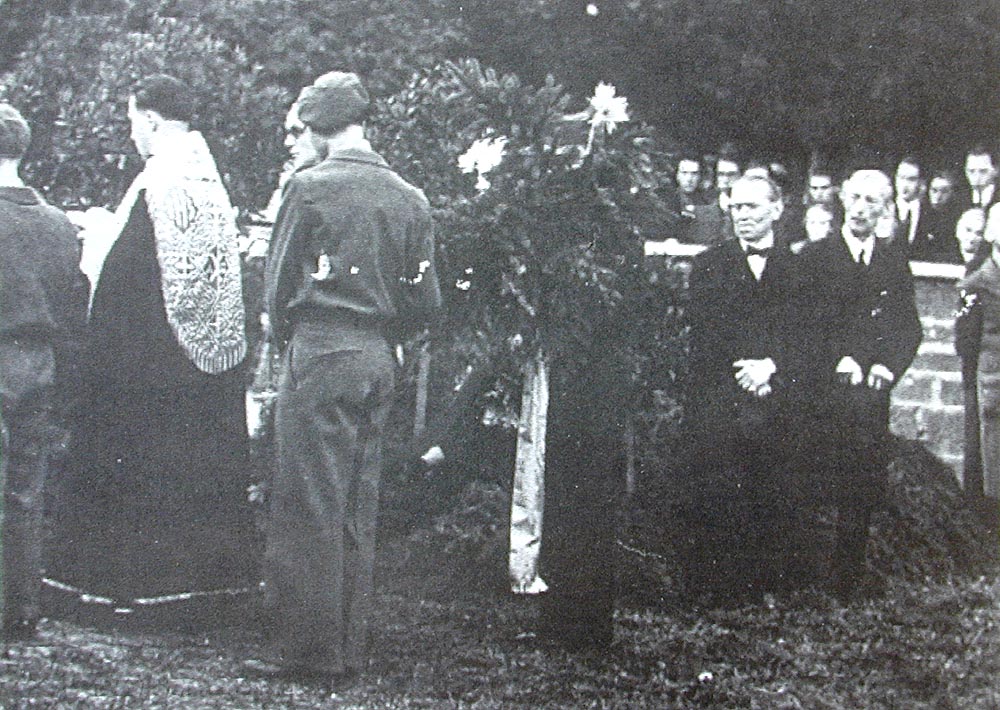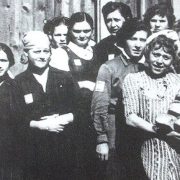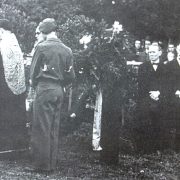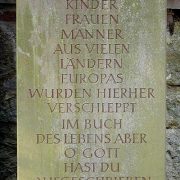Here is a "monument " in Mercedes-Benz industry about the forced labour.
There is no mention that the forced laborers were exterminating in Mercedes-Benz industry because of inhuman conditions and because there according to them "untermenschen". So nobody can understand that Mercedes-Benz is gulty for the extermination of hundert thousands of forced laborers.
There is also no mention about the origin of those slaves. There is any word like Soviet Union, Russians, Poles, Ukraine, Jews, Belarussians, Czechoslovakes, Yugoslavs, Greeks, Armenians, Communists. Not a word
And the real story
https://zeitreise-bb.de/zwang/
Ost-West-Gefälle bis in den Tod
Zwangsarbeiter in Sindelfingen
Zwangsarbeiter gab es während des Zweiten Weltkriegs offiziell nicht. In der Naziterminologie war stets von „Fremdarbeitern“ die Rede – ein Begriff, der Angeworbene, Verschleppte, Kriegsgefangene und KZ-Häftlinge auf einen Nenner bringen wollte. Auf jeden Fall verfälschte er die Wirklichkeit, denn von diesen 14 Millionen Menschen „sind keine 200 000 freiwillig gekommen“, wie Fritz Sauckel, Hitlers Bevollmächtigter für den Arbeitseinsatz, selbst erklärte. Was hieß es, Zwangsarbeiter zu sein? Am Beispiel Sindelfingen wird das deutlich.
Am 18. Januar 1940 kamen die ersten Zwangsarbeiter, 20 kriegsgefangene Polen, an. Sie wurden zu Holzhauerarbeiten eingesetzt und in einem Nebengebäude des Wirtshauses Hirsch untergebracht. In den folgenden fünf Jahren erhöhte sich ihre Zahl auf 3422 Menschen, überwiegend aus der Sowjetunion (1154) und aus Frankreich (1142): In Sindelfingen lag der Ausländeranteil plötzlich bei 29 Prozent.
Die meisten von ihnen – insgesamt 2841 – waren bei Daimler beschäftigt. Die Firma war einer der wirklich großen Rüstungsbetriebe (sie produzierte Teile der Kampfflugzeuge Me 109, Me 110 und Me 210 sowie Heckteile der „Wunderwaffe“ V2) und hatte deshalb einen enormen Bedarf an Arbeitskräften.
Frauen ging es noch schlechter
Die Franzosen waren überwiegend unter Druck (Entzug der Lebensmittelmarken) in Frankreich angeworben, die „Ostarbeiter“ fast durchweg verschleppt worden. Zwischen beiden Gruppen gab es erheblichen Unterschied – die „Ostarbeiter“ galten als „Untermenschen“ und waren deshalb in jeder Hinsicht gegenüber den „Westarbeitern“ benachteiligt. Und den „Ostarbeiterinnen“ ging es noch schlechter als den Männern. „Die Ostarbeiter hatten viel schlechtere Verpflegung als wir. Wir Westarbeiter haben häufig Brot über den Zaun des Ostarbeiterlagers geworfen. Ihr Lager wurde wie ein Kriegsgefangenenlager bewacht, und sie durften auch keine Gastwirtschaften besuchen“, erinnerte sich Christian Clermonts 43 Jahre nach Kriegsende an die Verhältnisse in Sindelfingen. Am lächerlich kleinen Beispiel der Tabakzuteilung wird die ganze Naziideologie deutlich: „Westarbeitern“ stand die Ration einer deutschen Frau zu, Polen und Russen die Hälfte davon, Polinnen und Russinnen bekamen nichts.
Bei Daimler beschäftigte Ostarbeiterinnen. Den Frauen ging es schlechter, als dieses offizielle Foto zeigt. (Foto: Mercedes-Benz Classic)
Das „Ost-West-Gefälle“ ging bis zum Tod: 53 Zwangsarbeiter sind in Sindelfingen gestorben. Von den 28 „Westarbeitern“ kamen 23 bei Bombenangriffen um, von den 25 „Ostarbeitern“ starben 23 an Krankheiten (an „Ernährungsstörung“ oder „Todesursache unbekannt“). Und von den 52 „Ostarbeiterkindern“, die in Sindelfingen geboren wurden, erlebten 19 das Kriegsende nicht. Dabei hatten es die Zwangsarbeiter bei Daimler Sindelfingen vergleichsweise besser als in vielen anderen Großbetrieben: Die Verpflegung war teilweise reichlicher als vorgeschrieben, auch die „Ostarbeiter“ durften – hart am Rande der Legalität – bei Luftangriffen den Stollen am Goldberg aufsuchen. Und viele Bürgerinnen und Bürger begegneten ihnen menschlich, teilweise unter Gefahr für sie selbst. Dennoch waren die Jahre in Sindelfingen für alle Zwangsarbeiter eine bittere und lange Zeit. Die Daimler-Benz AG hat sich 1988 zu ihrer Verantwortung bekannt und 20 Millionen DM an zuständige Organisationen gezahlt; in Untertürkheim steht heute ein Denkmal, das an die Zwangsarbeiter erinnert. Das offizielle Sindelfingen hat dieses Kapitel jahrzehntelang weggeschoben. Bis 1985 waren die Gräber verstorbener „Ostarbeiter“ auf dem Alten Friedhof in einem erbärmlichen Zustand, danach wurden zwei Sammelgräber mit Bronzeplatten eingerichtet. Und seit 1992 steht auf dem Alten Friedhof eine Gedenktafel für die Sindelfinger Zwangsarbeiter.
Späte Entschädigung
Heute, fast 54 Jahre nach Kriegsende, sollen die Zwangsarbeiter endlich entschädigt werden – aber die ungleiche Behandlung geht offenbar weiter: Die „Ostarbeiter“, die mehr leiden mussten, sollen zum Ausgleich weniger bekommen. Ein früherer Zwangsarbeiter in der Ukraine oder in Russland hat es im Leben zumeist schwerer gehabt als sein Kollege aus dem Westen. Warum soll er also nicht – zumindest – in gleicher Höhe entschädigt werden?
Beerdigung der bei einem Luftangriff gestorbenen holländischen Zwangsarbeiter. (Foto: Mercedes-Benz Classic)
https://www.zwangsarbeit-archiv.de/buecher_medien/literatur/b00043/index.html
Zwangsarbeit bei Daimler-Benz
Hopmann, Barbara/ Spoerer, Mark/ Weitz, Birgit/ Brüninghaus, Beate – 1994
"Die wissenschaftliche Aufsatzsammlung thematisiert Zwangsarbeit in der Rüstungsindustrie bei der Firma Daimler-Benz. Besonders berücksichtigt werden Polen, ""Ostarbeiter"", Juden, KZ-Häftlinge, Westeuropäer, Italiener/italienische Militärinternierte und Kriegsgefangene. Das Buch enthält ausführliche Texte, Fotos und Bilder."
Titel
Zwangsarbeit bei Daimler-Benz
Verfasser
Hopmann, Barbara/ Spoerer, Mark/ Weitz, Birgit/ Brüninghaus, Beate
Verlag
Stuttgart: Franz Steiner 1994
Schlagwörter
Wissenschaftliche Publikation
Kennung
ISBN 3-515-06440-0
zeitliche und räumliche Reichweite
Stuttgart, Baden-Württemberg, Deutschland
https://m.bpb.de/geschichte/deutsche-geschichte/der-zweite-weltkrieg/199405/kriegswirtschaft-und-zwangsarbeit
The use of forced labour and slavery in Nazi Germany and throughout German-occupied Europe during World War II took place on an unprecedented scale. It was a vital part of the German economic exploitation of conquered territories. It also contributed to the mass extermination of populations in German-occupied Europe. The Nazi Germans abducted approximately 12 million people from almost twenty European countries; about two thirds came from Central Europe and Eastern Europe. Many workers died as a result of their living conditions – extreme mistreatment, severe malnutrition, and worst tortures were the main causes of death. Many more became civilian casualties from enemy (Allied) bombing and shelling of their workplaces throughout the war. At its peak the forced labourers comprised 20% of the German work force. Counting deaths and turnover, about 15 million men and women were forced labourers at one point during the war
Whether 10,000 Russian females fall down from exhaustion while digging an antitank ditch interests me only in so far as the antitank ditch for Germany is finished.
Use of forced labour by Nazi Germany

Street round-up (Polish łapanka [waˈpanka]) of random civilians to be deported to Germany for forced labour; Warsaw's Żoliborz district, 1941
Foreign forced labourers
|
| Numbers |
10 million (1944 est.)
including:
6.5 million civilians
2.2 million POWs
1.3 million camp inmates |
|---|
| Abducted |
|
|---|
| Place of origin |
USSR (33.6%), Poland (21.7%), France (17.1%), Belgium, Netherlands, Czechoslovakia, Yugoslavia, Italy, Bulgaria, Hungary, Denmark, Greece, Spain, Romania and others
|
|---|
|

Foreign civilian forced labourers in Nazi Germany by country of origin, January 1944 with transfer payment to the Reich per labourer Source: Beyer & Schneider
| Countries | Number | % of total | RM |
|---|
| Total | 6,450,000 | 100.0% | |
|---|
| Occupied Central and Eastern Europe | 4,208,000 | 65.2% | median 15 RM |
|---|
| Czechoslovakia | 348,000 | 5.4% | |
| Poland | 1,400,000 | 21.7% | 33.5 RM |
| Yugoslavia | 270,000 | 4.2% | |
| USSR including annexed lands | 2,165,000 | 33.6% | 4 RM |
| Hungary | 25,000 | 0.4% | |
| Greece | 20,000 | 0.3% | |
| Occupied Western Europe | 2,155,000 | 33.4 | median 700 RM |
|---|
| France (except Alsace-Lorraine) | 1,100,000 | 17.1% | 487 RM |
| Norway | 2,000 | – | |
| Denmark | 23,000 | 0.4% | |
| Netherlands | 350,000 | 5.4% | |
| Belgium | 500,000 | 7.8% | 913 RM |
| Italy | 180,000 | 2.8% | 1,471 RM |
| German allies and neutral countries | 87,000 | 1.3% | |
|---|
| Bulgaria | 35,000 | 0.5% | |
| Romania | 6,000 | 0.1% | |
| Spain | 8,000 | 0.1% | |
| Switzerland | 18,000 | 0.3% |
ArbeitskräftegruppeSterblichkeit (pro Jahr)
Deutsche Arbeiter4 ‰Dänische Arbeiter4 ‰Italienische Arbeiter (1938–42)3 ‰Niederländische Arbeiter10 ‰Belgische Kriegsgefangene6 ‰Britische Kriegsgefangene8 ‰Französische Kriegsgefangene8 ‰Italienische Kriegsgefangene (1943–45)40 ‰Sowjetische Kriegsgefangene
≈1000 ‰KZ-Häftlinge
≈1000 ‰
| Herkunftsland | Anzahl 1939 bis 1945 | Zwangsarbeiter per Aug/Sep 1944 |
|---|
| Gesamt | Zivil | Kriegsgefangene | Gesamt | Zivil | Kriegsgefangene |
|---|
| Sowjetbürger | 4.725.000 | 2.775.000 | 1.950.000 | 2.758.312 | 2.126.753 | 631.559 |
| Polen | 1.900.000 | 1.600.000 | 300.000 | 1.688.080 | 1.659.764 | 28.316 |
| Franzosen | 2.335.000 | 1.050.000 | 1.285.000 | 1.254.749 | 654.782 | 599.967 |
| Italiener | 1.455.000 | 960.000 | 495.000 | 585.337 | 158.099 | 427.238 |
| Belgier | 440.000 | 375.000 | 65.000 | 253.648 | 203.262 | 50.386 |
| Niederländer | 475.000 | 475.000 | – | 270.304 | 270.304 | – |
| Tschechen | 355.000 | 355.000 | – | 280.273 | 280.273 | – |
| Serben | 210.000 | N/A | N/A | 37.607 | 37.607 | – |
| Kroaten | 100.000 | 100.000 | – | 60.153 | 60.153 | – |
| Slowaken | 100.000 | 100.000 | – | 37.607 | 37.607 | – |
| Dänen | 80.000 | 80.000 | – | 15.970 | 15.970 | – |
| Balten | 75.000 | 75.000 | – | 44.799 | 44.799 | – |
| Ungarn | 45.000 | 45.000 | – | 24.263 | 24.263 | – |
| Sonstige | 440.000 | 440.000 | – | 199.437 | 199.437 | – |
UnternehmenJahrBetrag in DMEmpfängerGrundI.G. Farbenindustrie AG195730 Miojüdische und nicht-jüdische ZwangsarbeiterWollheim-Prozess in FrankfurtKrupp-Konzern195910 Miojüdische Zwangsarbeiter aus KonzentrationslagernVorbereitung einer Sammelklage in New YorkAEG-Telefunken19604 MioZwangsarbeiterVermeidung eines Präzedenzfalles aus SammelklageSiemens19627 Miojüdische ZwangsarbeiterJewish Claims Conference legte firmen-internen Bericht von 1945 vorRheinmetall19662,5 Miojüdische Zwangsarbeiter (nicht-jüdische lehnte das Unternehmen 1969 ab)zur politischen Absicherung eines Waffengeschäftes mit den USADeutsche Bank für Flick-Konzern19865 MioZwangsarbeiter des Flick-Unternehmens Dynamit Nobelzur politischen Absicherung des lukrativen Weiterverkaufs Dynamit Nobel durch Deutsche BankDaimler Benz1988?20 MioFörderung von Alten- und Pflegeheimenunbekannt
_-_Google_Art_Project.jpg)










